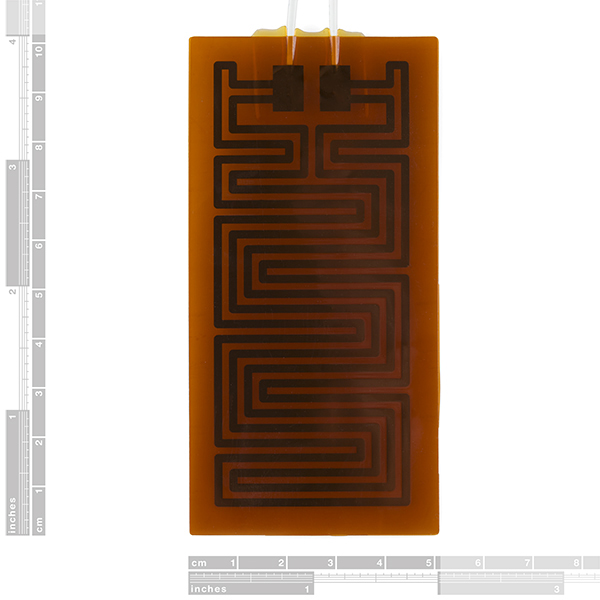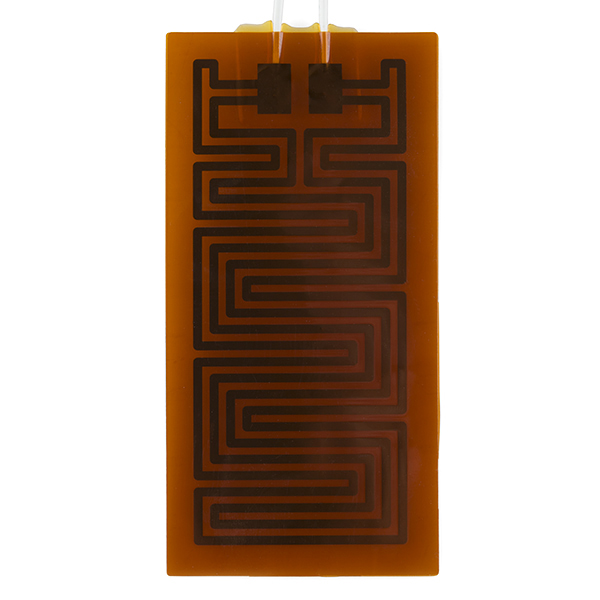Heating Panel - 12V (4" x 2")
These small heating panels are perfect for any project that requires a lot of heat in a small space. Simply attach a 12V power source up to the 22AWG wire and this panel will heat up very fast. We've found, once powered up, these guys can be used as great coffee heaters.
Even though it's only 4" x 2", it can get up to 500 degrees F. For it's size this is a very powerful heating panel! Two layers of Kapton are held together by a Teflon bonding adhesive that encases a resistive foil, which allows for such a high maximum temperature.
- Voltage: 12V
- Watt Density: 2.5 W/in2 (0,39 W/cm2)
- Total Wattage: 20W
- Max Operating Temperature: 500°F (260°C)
- 24in 22AWG Wire Connector
- Low Out Gassing
Heating Panel - 12V (4" x 2") Product Help and Resources
Core Skill: Electrical Prototyping
If it requires power, you need to know how much, what all the pins do, and how to hook it up. You may need to reference datasheets, schematics, and know the ins and outs of electronics.
Skill Level: Rookie - You may be required to know a bit more about the component, such as orientation, or how to hook it up, in addition to power requirements. You will need to understand polarized components.
See all skill levels
Comments
Looking for answers to technical questions?
We welcome your comments and suggestions below. However, if you are looking for solutions to technical questions please see our Technical Assistance page.
Customer Reviews
No reviews yet.




Whats the best way to mount this to a piece of metal? Thermal adhesive? Can they handle temps. greater than 150C?
$35 wow. In all fairness you can get a peltier cooler which also heats that's also 12v and 120 watts for under $12 on amazon that can run stable around 200-240 degrees (f) stable. I use these for both purposes, the added benefit that you can cool as well makes them invaluable. But I guess if you need 500 degrees.
kapton heaters come in many sizes, shapes and R. An interesting tib bit, they are used in most spacecraft to keep various parts at certain temperatures. We used them on LRO and others at GSFC. Can be attached with 2216 two part epoxy instead of expensive space qual'd stuff. You need to be really careful about the B and A quantities. There are probably others that are premixed.
so this thing draws almost two amps correct...does sparfun sale or know if there is a battery that can last more than an our (more than 2000mah) that you sell ? why not make a temperature controller pcb... I have an idea for a wearable project but want something that will last more than an hour as I need to reach and sustain 260 degrees
3D printer bed heaters!
Measured resistance? Just cross checking the I=V/R math, I get 0.6 Ohms but I could have done something backwards.
Careful- they give power (Watts), not current (Amps). Since P = I*V, and I=V/R, you get the equation P = V^2 / R. Solving for R here yields 7.2 Ohms.
The resistance will almost certainly change with temperature too and will very likely increase with an increase in heat.
Are these flexible? Could I wrap it around a metal pipe with a 1 cm diameter for example?
I would say no.
Sure, the materials used are flexible and could be wrapped around a cylinder.
But a cylinder that small? No. Think about it... a cylinder 10mm in diameter would have a circumference of about 1.25 inches. That's smaller than either axis of the part, so you would have a condition where heating element wraps over heating element. That can't be good.
Then there's the connections. Those look to be soldered, which makes bits of the sheet non flexible.
I expect that the device has to wrapped around a cylinder with the 4" edge around the cylinder, so the minimum cylinder diameter would be about 1.3 inches.
So temped to make a reflow out of a few of these!!!!
How fast do these heat up, and how well do they retain their heat? It would be nice to get a video like the one for the other heating pads.
That's going to depend on the thermal mass they're connected to.
20 watts is about equivalent to 68 BTU/hr.
The definition of a BTU is the energy needed to raise one pound of water one degree Fahrenheit.
So if you had a great big coffee cup that held one pound of coffee (about 2 cups.) and you stuck this in it, it would go from room temperature (72 degrees) to 140 degrees in one hour.